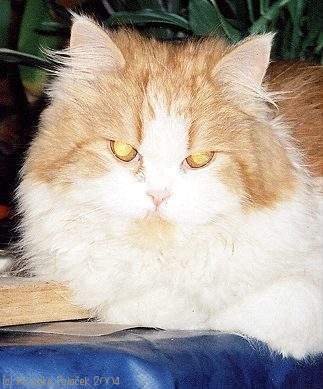Summary

Several factors can contribute to a Persian cat’s tail losing its fluffiness, including seasonal shedding, stud tail, allergies, parasites, overgrooming, and health issues. To make your Persian cat’s tail more fluffy, you can use grooming techniques like regular brushing and bathing, as well as recommended products rich in omega-3 fatty acids, vitamins, and moisturizing ingredients. Maintaining a consistent grooming schedule and using the right products can help restore the fluffiness of your Persian cat’s tail.
What Causes a Persian Cat’s Tail to Lose Its Fluffiness?

1. What is Seasonal Shedding and How Does it Affect a Persian Cat’s Tail?
Cats, especially those with thick coats like Persians, tend to shed more during seasonal changes. This natural shedding process can make the tail appear less fluffy.
2. What is Stud Tail and How Can it Affect a Persian Cat’s Tail?
Stud tail is a condition, more common in intact males, that involves an overproduction of sebum near the base of the tail, leading to hair loss and greasiness. However, it can also affect neutered males and females.
3. How Can Allergies Cause a Persian Cat’s Tail to Lose Its Fluffiness?
Allergic reactions to food, environment, or skin conditions can cause hair loss on the tail. Switching to a hypoallergenic diet and using hypoallergenic grooming products can help.
4. What Role Do Parasites Play in a Persian Cat’s Tail Losing Its Fluffiness?
Fleas, ticks, and other parasites can cause hair loss due to excessive scratching and biting.
5. How Can Overgrooming Affect a Persian Cat’s Tail Fluffiness?
Psychogenic alopecia, where the cat excessively licks and scratches due to anxiety or stress, can lead to hair loss.
6. What Health Issues Can Contribute to a Persian Cat’s Tail Losing Its Fluffiness?
Endocrine disorders, skin infections, and other medical conditions can affect the coat’s health and fluffiness.
7. How Can Poor Grooming Lead to a Persian Cat’s Tail Losing Its Fluffiness?
Failure to regularly groom a Persian cat can lead to matting and tangling, which can make the tail appear less fluffy.
How to Make a Persian Cat’s Tail More Fluffy?
1. What Grooming Techniques Can Help Restore Fluffiness to a Persian Cat’s Tail?
- Regular Brushing: Use a high-quality brush or comb specifically designed for long-haired cats to prevent matting and tangling. Daily brushing is ideal, but at least 2-3 times a week is recommended.
- Bathing: Bathe your cat occasionally, but not too frequently, as this can strip the coat of its natural oils. Use a mild shampoo and conditioner suitable for long-haired cats.
2. What Recommended Products Can Help Make a Persian Cat’s Tail More Fluffy?
- Shampoos and Conditioners: Look for products rich in omega-3 fatty acids, vitamins, and minerals that promote coat health. Avoid harsh chemicals that can dry out the coat.
- Supplements: Omega-3 fatty acid supplements can help improve the overall health and fluffiness of your cat’s coat. Consult with your veterinarian before adding any supplements to your cat’s diet.
3. What Ingredients Should You Look for in Products to Improve a Persian Cat’s Tail Fluffiness?
- Omega-3 Fatty Acids: These help in maintaining a healthy and shiny coat.
- Vitamins and Minerals: Essential for overall coat health and growth.
- Moisturizing Ingredients: Help to keep the coat hydrated and prevent dryness.
What is the Ideal Grooming Schedule and Product Quantities for a Persian Cat?
1. What is the Recommended Grooming Schedule for a Persian Cat?
- Daily Brushing: Spend at least 10-15 minutes brushing your cat, focusing on areas prone to matting.
- Weekly Grooming Sessions: Set aside a longer session (about 30 minutes) once a week for more thorough grooming, including nail trimming and ear cleaning.
2. How Much Shampoo and Conditioner Should You Use on a Persian Cat?
- Shampoo and Conditioner: Use the amount recommended on the product label. Typically, a small amount (about a teaspoon) is sufficient for a full bath.
- Supplements: Follow the dosage instructions provided by the manufacturer or as advised by your veterinarian.
What are Some Successful Grooming Routines and Products for Persian Cats?
Many Persian cat owners have found success with the following:
- Furminator Brushes: These are designed to reduce shedding and prevent hairballs, and are particularly effective for long-haired breeds.
- Oatmeal Shampoos: These are gentle and moisturizing, helping to keep the coat healthy and fluffy.
- Regular Use of Conditioners: Leave-in conditioners or detangling sprays can help keep the coat soft and manageable.
What Behavioral Signs Should You Watch for in a Persian Cat?
- Excessive Scratching or Licking: This could indicate allergies, parasites, or skin infections.
- Changes in Appetite or Energy Levels: These can be signs of underlying health issues affecting the coat’s health.
- Visible Hair Loss or Bald Patches: These can indicate conditions like stud tail, allergies, or parasites.
References
- Reddit – CATHELP: Discussion on seasonal shedding and grooming practices.
- VCA Animal Hospitals: Detailed information on stud tail, including causes and treatment.
- Wag Walking: Explanation of stud tail, its symptoms, and treatment options.
- Catster: Common reasons for hair loss on a cat’s tail, including allergies and parasites.
- JustAnswer: Advice from a veterinary nurse on grooming practices and potential causes of hair loss.
